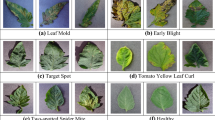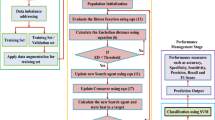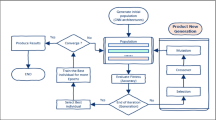Abstract
To identify a plant disease accurately one should have a lot of experience and in-depth knowledge in a particular field. Identifying the plant diseases using manual intervention is often erroneous, time-consuming, and not a cost-effective option. Shallow Machine learning architectures were widely deployed for the automatic identification of the tomato leaf diseases, but their feature extraction process is highly time-consuming. Nowadays, the power of Deep Learning is been exploited by various researchers to identify the diseases present in plants. This paper utilizes a CNN approach to classify four different types of leaf diseases(bacterial spot, septoria leaf spot, late blight, and tomato mosaic virus) in a tomato plant without using any manual intervention. A dataset comprising of 6208 images of four classes of leaf diseases was acquired from the Plant Village database for classification. CNN is considered an effective option for solving a wide range of image processing tasks but its architecture is a little bit complex. To minimize this complexity and optimize the parameters present in the CNN, a binary solution encoding scheme is proposed using an Improved Crossover based Monarch Butterfly Optimization (ICRMBO) algorithm. This solution encoding technique implemented here eliminates the need for manual effort for designing the CNN architecture. Two convolutional architectures namely Vgg16 and Inception V3 were used in this work and they were optimized using the ICRMBO algorithm. The Inception V3 and Vgg16 architectures are widely deployed in this work to ease the training process, improve the generalization ability of the CNN network, and increase the classification accuracy. The overall test accuracies obtained for both the Vgg16 and Inception V3 was 99.98% and 99.94% when optimized with the ICRMBO algorithm. The proposed method augmented the performance in terms of high precision, sensitivity, and specificity values and obtained an overall classification accuracy of 99%. The significance and effectiveness of the proposed method over other methods are identified through the comparative analysis conducted.











Similar content being viewed by others
References
Armbrust M, Fox A, Griffith R, Joseph AD, Katz R, Konwinski A, Lee G, Patterson D, Rabkin A, Stoica I, Zaharia M (2010) A view of cloud computing. Commun ACM 53(4):50–58
Ashourloo D, Aghighi H, Matkan AA, Mobasheri MR, Rad AM (2016) An investigation into machine learning regression techniques for the leaf rust disease detection using hyperspectral measurement. IEEE Journal of Selected Topics in Applied Earth Observations and Remote Sensing 9(9):4344–4351
Ballester P, Araujo RM (2016) On the performance of GoogLeNet and AlexNet applied to sketches. In Thirtieth AAAI Conference on Artificial Intelligence
Chouhan SS, Kaul A, Singh UP, Jain S (2018) Bacterial foraging optimization based radial basis function neural network (BRBFNN) for identification and classification of plant leaf diseases: an automatic approach towards plant pathology. IEEE Access 6:8852–8863
Chouhan SS, Singh UP, Jain S (2020) Applications of computer vision in plant pathology: a survey. Archives of computational methods in engineering 27(2):611–632
Da Costa AZ, Figueroa HE, Fracarolli JA (2020) Computer vision based detection of external defects on tomatoes using deep learning. Biosyst Eng 190:131–144
Darwish A, Ezzat D, Hassanien AE (2020) An optimized model based on convolutional neural networks and orthogonal learning particle swarm optimization algorithm for plant diseases diagnosis. Swarm and Evolutionary Computation 52:100616
Deng J, Dong W, Socher R, Li LJ, Li K, Fei-Fei L (2009) Imagenet: a large-scale hierarchical image database. In 2009 IEEE conference on computer vision and pattern recognition (pp. 248-255). IEEE.
Hughes D, Salathé M (2015) An open access repository of images on plant health to enable the development of mobile disease diagnostics. arXiv preprint arXiv:1511.08060
Karthik R, Hariharan M, Anand S, Mathikshara P, Johnson A, Menaka R (2020) Attention embedded residual CNN for disease detection in tomato leaves. Appl Soft Comput 86:105933
Kaur S, Pandey S, Goel S (2018) Semi-automatic leaf disease detection and classification system for soybean culture. IET Image Process 12(6):1038–1048
Kavitha D, Ravikumar S (2021) IOT and context‐aware learning‐based optimal neural network model for real‐time health monitoring. Trans Emer Telecommun Technol 32(1):e4132
Leibetseder A (2017) Manfred Jürgen Primus, Stefan Petscharnig, and Klaus Schoeffmann. "Image-based smoke detection in laparoscopic videos." In Computer Assisted and Robotic Endoscopy and Clinical Image-Based Procedures, pp. 70–87. Springer, Cham
Li M, Ma JG, Zhao J (2009) Automatic generating test paper strategy based on improved particle swarm optimization. In 2009 IEEE international symposium on IT in Medicine & Education (Vol. 1, pp. 711-715). IEEE
Li G, Zhang C, Lei R, Zhang X, Ye Z, Li X (2020) Hyperspectral remote sensing image classification using three-dimensional-squeeze-and-excitation-DenseNet (3D-SE-DenseNet). Remote Sensing Letters 11(2):195–203
Liang Q, Xiang S, Hu Y, Coppola G, Zhang D, Sun W (2019) PD2SE-net: computer-assisted plant disease diagnosis and severity estimation network. Comput Electron Agric 157:518–529
Marston S, Li Z, Bandyopadhyay S, Zhang J, Ghalsasi A (2011) Cloud computing—the business perspective. Decis Support Syst 51(1):176–189
Nagaraju M, Chawla P (n.d.) Systematic review of deep learning techniques in plant disease detection. International Journal of System Assurance Engineering and Management, 1–14
Nazki H, Yoon S, Fuentes A, Park DS (2020) Unsupervised image translation using adversarial networks for improved plant disease recognition. Comput Electron Agric 168:105117
Rahman CR, Arko PS, Ali ME, Khan MAI, Apon SH, Nowrin F, Wasif A (2020) Identification and recognition of rice diseases and pests using convolutional neural networks. Biosyst Eng 194:112–120
Rangarajan AK, Purushothaman R (2020) Disease classification in eggplant using pre-trained VGG16 and MSVM. Sci Rep 10(1):1–11
Ravikumar S, Kavitha D (2020) IoT based home monitoring system with secure data storage by Keccak–Chaotic sequence in cloud server. J Ambient Intell Humaniz Comput, pp 1–13
Ravikumar S Kavitha D (2021) IOT based autonomous car driver scheme based on ANFIS and black widow optimization. J Ambient Intelli Humaniz Comput, pp 1–14
Ravikumar S, Chandrasekaran S, Ramesh S (2016) Safety assessment of distributed automotive software system model with design for traceability. Asian J Inf Technol 15(11):1799–1815
Rejeesh MR (2019) Interest point based face recognition using adaptive neuro fuzzy inference system. Multimed Tools Appl 78(16):22691–22710
Rejeesh MR, Thejaswini P (2020) MOTF: Multi-objective optimal trilateral filtering based partial moving frame algorithm for image denoising. Multimed Tools Appl 79(37–38):28411–28430
Rubanga DP, Loyani LK, Richard M, Shimada S (2020) A deep learning approach for determining effects of Tuta Absoluta in tomato plants. arXiv preprint arXiv:2004.04023
Simonyan K (2020) Zisserman (2014) A very deep convolutional networks for large-scale image recognition. arXiv preprint arXiv:1409.1556, 7923
Storn R, Price K (1997) Differential evolution–a simple and efficient heuristic for global optimization over continuous spaces. J Glob Optim 11(4):341–359
Sundararaj V (2019) Optimal task assignment in mobile cloud computing by queue based ant-bee algorithm. Wirel Pers Commun 104(1):173–197
Sundararaj V (2019) Optimised denoising scheme via opposition-based self-adaptive learning PSO algorithm for wavelet-based ECG signal noise reduction. Int J Biomed Eng Technol 31(4):325
Sundararaj V, Anoop V, Dixit P, Arjaria A, Chourasia U, Bhambri P, MR, R. and Sundararaj, R. (2020) CCGPA-MPPT: Cauchy preferential crossover-based global pollination algorithm for MPPT in photovoltaic system. Prog Photovolt Res Appl 28(11):1128–1145
Tanzi L, Vezzetti E, Moreno R, Moos S (2020) X-ray bone fracture classification using deep learning: a baseline for designing a reliable approach. Appl Sci 10(4):1507
Tanzi L, Piazzolla P, Vezzetti E (2020) Intra-operative surgery room management: a deep learning perspective. Int J Med Robot Comp
Ucar F, Korkmaz D (2020) COVIDiagnosis-net: deep Bayes-SqueezeNet based diagnostic of the coronavirus disease 2019 (COVID-19) from X-ray images. Medical hypotheses, 109761
Verma S, Chug A, Singh AP (2020) Application of convolutional neural networks for evaluation of disease severity in tomato plant. J Discret Math Sci Cryptogr 23(1):273–282
Vinu S (2016) An efficient threshold prediction scheme for wavelet based ECG signal noise reduction using variable step size firefly algorithm. Int J Intell Eng Syst 9(3):117–126
Vinu S, Muthukumar S, Kumar RS (2018) An optimal cluster formation based energy efficient dynamic scheduling hybrid MAC protocol for heavy traffic load in wireless sensor networks. Comput Secur 77:277–288
Wang GG, Deb S, Cui Z (2019) Monarch butterfly optimization. Neural Comput & Applic 31(7):1995–2014
Xia X, Xu C, Nan B (2017) Inception-v3 for flower classification. In 2017 2nd international conference on image, vision and computing (ICIVC) (pp. 783-787). IEEE
Yu F, Croso GS, Kim TS, Song Z, Parker F, Hager GD, Reiter A, Vedula SS, Ali H, Sikder S (2019) Assessment of automated identification of phases in videos of cataract surgery using machine learning and deep learning techniques. JAMA network open 2(4):e191860–e191860
Zhang Y, Song C, Zhang D (2020) Deep learning-based object detection improvement for tomato disease. IEEE Access 8:56607–56614
Author information
Authors and Affiliations
Corresponding author
Additional information
Publisher’s note
Springer Nature remains neutral with regard to jurisdictional claims in published maps and institutional affiliations.
Rights and permissions
About this article
Cite this article
Nandhini, S., Ashokkumar, K. Improved crossover based monarch butterfly optimization for tomato leaf disease classification using convolutional neural network. Multimed Tools Appl 80, 18583–18610 (2021). https://doi.org/10.1007/s11042-021-10599-4
Received:
Revised:
Accepted:
Published:
Issue Date:
DOI: https://doi.org/10.1007/s11042-021-10599-4




